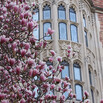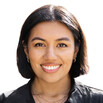Ten Years of the Supreme Court Advocacy Clinic
Founded in 2006, the Law School’s Supreme Court Advocacy Clinic was one of the first of its kind among American law schools. The clinical course provides a wide range of clients with pro bono representation before the U.S. Supreme Court. Now approaching its tenth anniversary, the course has enrolled 121 students and been involved in more than seventy cases before the Court.
No judicial body in the world is more closely observed than the U.S. Supreme Court, yet its inner workings remain obstinately private. When the nine justices are in conference, discussing which cases they will accept and deliberating cases for which they have already heard oral arguments, no one else is allowed in the meeting. No clerks or visitors are allowed to enter the conference room, and there are no formal records of the discussions.
In its 2014 term, the Court received 7,033 cases for consideration and decided to hear just 75 of them, or a little more than 1 percent. To decide which cases to accept, four of the justices must vote in favor of granting a petition for a writ of certiorari—but unlike the written opinions of disposed cases that are made available to the public, the reasoning of denying or granting certiorari stays locked in the closed conference, except for the rare instances when a justice will issue a statement to explain her or his dissent from or agreement with the decision to hear a case.
Understanding the Court, in Theory and Practice
In 2006, Yale Law School began offering the Supreme Court Advocacy Clinic, which allows students to study and better understand the history and workings of the U.S. Supreme Court by having them actively participate in cases the court is considering. Drawing on the Law School’s unique network of alumni, scholars, and practitioners with first-hand experience working with the Court, the clinic began as the collaborative effort of multiple faculty members: Dan Kahan, the Elizabeth K. Dollard Professor of Law and Professor of Psychology, Brett Dignam (now clinical professor of law at Columbia Law School), and current co-directors of the clinic and visiting clinical lecturers Andrew Pincus and Charles Rothfeld.
In addition to Pincus and Rothfeld, the course is now co-taught by Jack Balkin, Knight Professor of Constitutional Law and the First Amendment, and Linda Greenhouse ’78 MSL, Knight Distinguished Journalist-in-Residence and Joseph Goldstein Lecturer in Law, as well as Michael Kimberly ’08 and Paul Hughes ’08, who were both students in the course’s inaugural term and who have returned as visiting clinical lecturers.
The clinic maintains an active docket of cases at both the certiorari and merits stages. Students in the course split into groups of four to work on an individual case throughout the year, with each team having a third-year student director who took the course the previous year.
In addition to regular guidance and consultation from Pincus, Rothfeld, Kimberly, and Hughes—who have all argued cases before the Court—the students explore the history and workings of the Court with Greenhouse, who draws on her decades-long experience covering the Court for the New York Times.
“As a longtime student of the Supreme Court but as a non-lawyer who will never argue there, I value my teaching experience in the clinic for the past seven years as an opportunity to immerse our students in the work of the Court and help launch them on what I expect will be career-long paths as astute Court-watchers,” said Greenhouse.
Further insights into the workings of the court are provided by a range of distinguished guest lecturers, which in past years have included Donald Verrilli, U.S. solicitor general; Jesse Wegman of the New York Times editorial board; Merrick Garland, chief judge of the U.S. Court of Appeals for the District of Columbia Circuit; and Joan Biskupic, legal affairs editor of Reuters and Supreme Court biographer.
The clinic has also been an active participant in the scholarly discussion about the court’s history and evolution. It has hosted a number of conferences, including the influential 2009 conference, “Important Questions of Federal Law: Assessing the Supreme Court’s Case Selection Process,” which examined the decline—most precipitously in the 1980s—in the number of cases the court decides to hear each year.
Case Work and Broader Impact
As the students engage a case throughout the year, they produce a substantial body of work, including petitions for certiorari, briefs in opposition to certiorari, amicus briefs, and merits briefs.
“We’ve had at least one merits case every year. Merits, amicus, and briefs in opposition to certiorari are very effective teaching devices,” explained Pincus. “They all tend to be highly focused. Students are able to refine their arguments over a period of time and produce work that has tremendous impact. And in opposing cert, you learn a lot about the factors involved in being granted cert.”
Pincus and Rothfeld have both argued multiple cases before the court as part of the clinic, including the case of Negusie v. Holder (No. 07-499), which Pincus successfully argued. The case involved Daniel Girmai Negusie, who was a citizen and resident of Eritrea during the Ethiopian-Eritrean war. When he was 18 years old, Negusie went to his town’s theater to watch a movie. Soldiers from the Eritrean military surrounded the theater and apprehended the audience members as they exited the building, shooting at anyone who tried to flee. The military had a well-documented history of beating, imprisoning, and sometimes killing citizens in order to force people into military service. After being imprisoned and tortured, Negusi was forced to serve as a prison guard, during which time he witnessed but did not participate in torture. After four years of coerced service, he fled, risking death in order to escape, and stowed away on a container ship bound for the United States, where upon arriving he filed for asylum.
According to the federal government, the existing statutes made Negusie automatically ineligible for asylum because he had worked as a prison guard, regardless of the fact that he had been forced into service by the threat of torture and death. On behalf of Negusie, Pincus argued that the Court should reverse the prohibition against granting asylum to a refugee who has participated in acts of persecution when the person’s actions were involuntary and a result of credible threats of death or torture. In the decision written by Justice Anthony Kennedy, the Court agreed with Pincus, overturning the previous rulings and directing the government to exercise its discretion to decide whether an individual in Negusie’s position should be eligible for asylum.
Students in the course participated in the entire process, contributing to the petition for a writ of certiorari and the reply, and then during the merits stage the brief for petitioner and the reply. This kind of hands-on work in high-stakes cases is what makes the clinic such an invigorating experience.
Rakim Brooks ’16 JD-MBA is a student currently in the clinic who has been working on Friedrichs v. California Teachers Association, which concerns whether public employees who don’t want to join the union representing them must pay fees that cover costs that the union incurs during the process of collective bargaining. The decision will have a profound impact on public employee unions, and many court observers are calling the case one of the most important of the term.
“My team recently completed an amicus brief in the Friedrichs case,” explained Brooks. “The team was incredible. What really shocked me was that, when we got the final copy, it really did contain most of what my student colleagues and I had written. It’s a testament to both how much trust Charles [Rothfeld] and Andy [Pincus] place in the team—and also the kind of collective effort we as students put into producing the final product.”
The clinic work left a strong impression on Brooks, who was a Rhodes Scholar before attending the Law School. “I’m now even more inclined to become an appellate lawyer—it’s the best mix of law and policy in that you win for an individual client but you also have the ability to set a rule for future cases. Aspiring lawyers dream of taking on the most complex and meaningful cases, and as students we get hands-on experience with those cases, with expert guidance from the most esteemed practitioners and analysts of the Supreme Court.”
If Brooks does go on to practice appellate law and argue cases before the Supreme Court, he will join five other alumni of the clinic who have already done so. In December, Michael Kimberly successfully argued Shapiro v. McManus, in which the court unanimously ruled that any challenge to the constitutionality of congressional re-districting must be allowed to come before a three-judge district court.
The other alumni of the clinic who have argued before the Court are Hughes (Hana Financial Inc. v. Hana Bank and Hana Financial Group), Ethan Davis ’08 (Ocasio v. United States), Fred Liu ’08 (Kansas v. Carr), and Roman Martinez ’08 (Yates v. United States; United States v. Kwai Fun Wong; Octane Fitness, LLC v. ICON Health & Fitness, Inc.; Musacchio v. United States).
“Now that Shapiro has been heard, five of the twelve graduates of the clinic’s first class—the class of 2008, and all currently associates at their respective firms or in the government—will have argued before the Supreme Court,” said Professor Jack Balkin. “This is remarkable, and something that we hope inspires our future graduates.”
Later in the Court’s current term, Charles Rothfeld will argue another high-profile case, which consolidates three separate cases on which students from the clinic have been working. The cases consider whether states may impose criminal penalties on people who exercise their Fourth Amendment right to refuse to submit to a test of their blood, breath, or urine when they are suspected of driving while intoxicated. “The Clinic students have been formulating our legal theories and putting together drafts of the briefs,” explained Rothfeld. “They’ll get a sense of how persuasive we’ve been when they attend the oral argument this spring.”
* Illustration of Michael B. Kimberly '08 who argued on behalf of the petitioners in Shapiro v. McManus on November 4. Credit: Art Lien.


